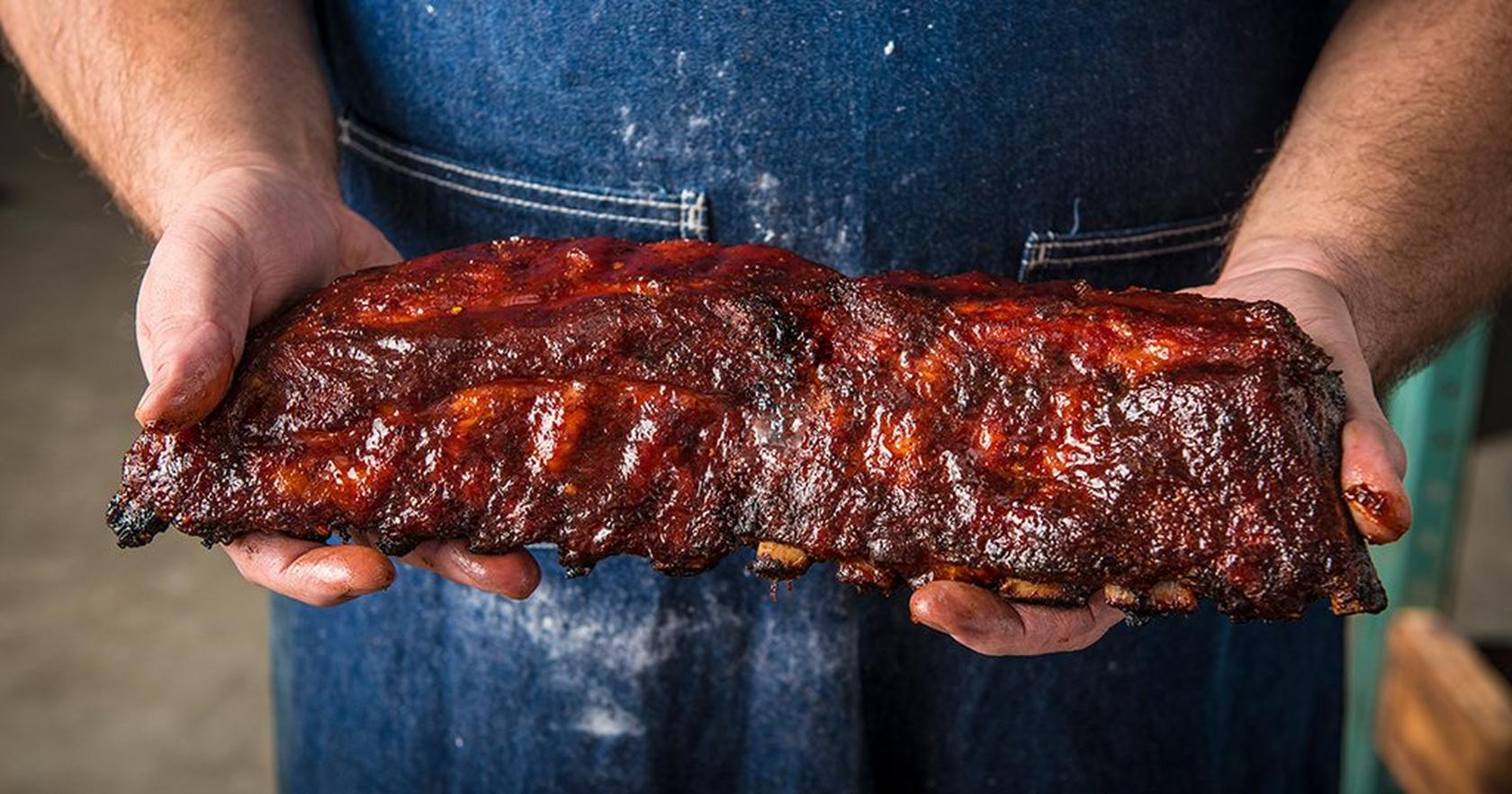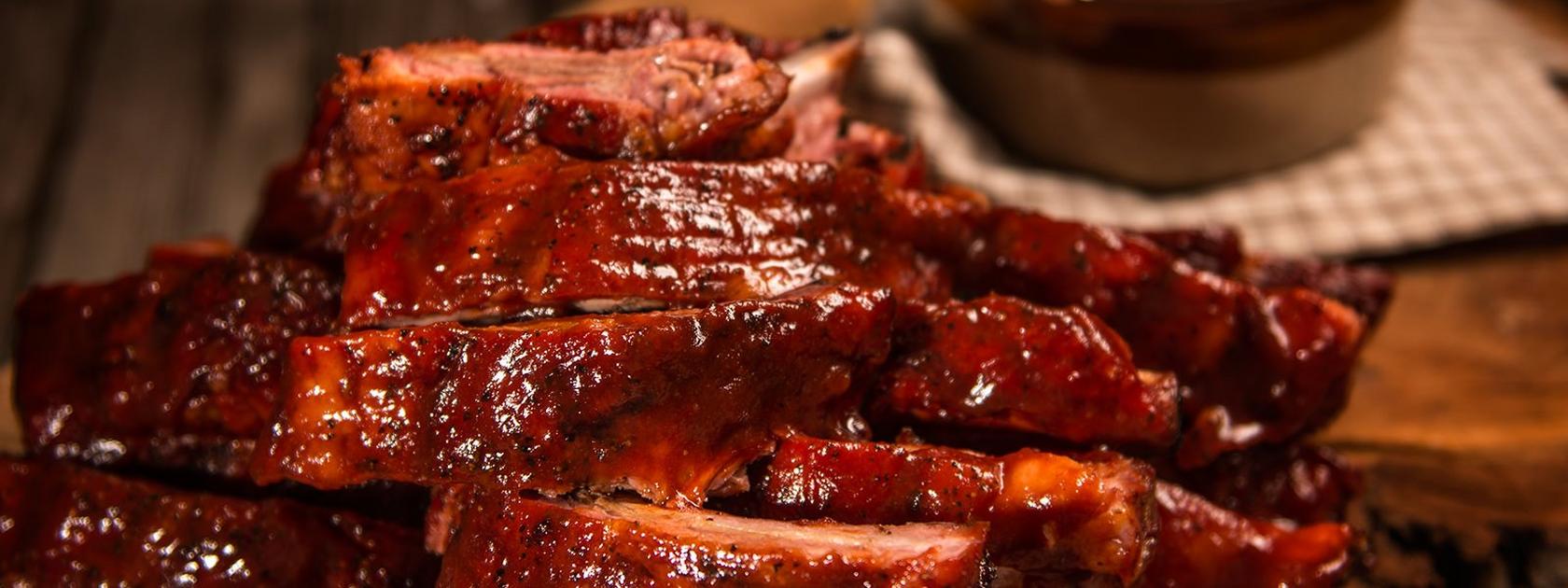
Nothing hits quite like an epic smoked ribs recipe. Moist, tender, satisfying, and nearly impossible to mess up, ribs, especially ribs on the Traeger can be the center of a delicious feast or an extremely hearty smoked appetizer.
What Are Baby Back Ribs?
There are a lot of different kinds of smoked ribs recipes, but for the sake of this article we are going to focus on the tenderest kind: baby back ribs.
Baby back ribs are a type of pork ribs from between the spine and loin sections of a pig. The loin contains the most tender pork, and baby back ribs include some of that meat. Baby back ribs are usually roasted or smoked.
What to Look for When Buying Baby Back Ribs
When you buy baby back ribs at the store, look for cuts that have more meat on the front of the ribs.
That meat is loin meat — it's very delicious and tender. For that reason, butchers sometimes choose to leave only a small portion of meat at the front of the rib, so that there is more meat on the loin. Get the meatiest cut you can.

How to Prepare Baby Back Ribs for Smoking
Prepping baby back ribs couldn't be simpler. Let's go through the basic steps.
Remove the Silver Membrane
Ribs have a thin membrane on the back that's unpleasantly chewy if left on. Remove it by holding a paper towel in one hand, and the center of the ribs in the other. Pull the membrane with the hand holding the paper towel. Once it starts to pull away, let the ribs lay flat on the counter, and continue pulling off the membrane.
Here's barbecue expert Diva Q showing how the method is done.
Season the Ribs
You should always apply rib rub before you cook. Sprinkle some sort of seasoning on both sides of the ribs. Your seasoning should cover the surface of the ribs but not be caked on. Approximately 2 tablespoons of seasoning per rack of ribs is a good amount.
It's perfectly fine to go simple with just salt and pepper, but most cooks like to add a little more excitement with a store-bought dry rub. Our Traeger Pork & Poultry Rub is an excellent choice.
Or you can make your own smoked ribs recipe rub from scratch. For our Traeger Baby Back Ribs, take a combination of brown sugar, paprika, garlic, onion, and chili powder, cayenne pepper, black pepper, white pepper, dried oregano, and ground cumin and liberally rub both sides. This recipe then takes a combination of apple juice, white grape juice, and honey and pours over the ribs around the 45 minute mark for even more flavor.
Ribs can take on a variety of flavors, so experiment with the flavors you like best.
Alternate Seasoning Options
A sprinkling of spice rub is the quick and easy way to season baby back ribs, but not the only way.
You can brine ribs ahead of time for extra flavor and tenderness, as in this recipe for Smoked Pomegranate Baby Back Ribs.
You can also spread a thin layer of paste on the ribs before adding the seasoning, to help the seasoning stick on.
Typically, an additional round of seasoning happens at the end of cooking — we'll get to that later.
Smoked Ribs Recipe
Once you've seasoned the ribs to your liking, it's time to smoke them. To get the full smoke flavor without overcooking the ribs, smoke for between 3 and 6 hours.
We recommend this Traeger baby back ribs recipe method:
2. Smoke Low & Slow – First Stage
Place the ribs bone‑side down on the grates and smoke them uninterrupted for about 45 minutes. During this stage, the rub develops a flavorful crust, and the ribs start to absorb that gentle apple‐wood smoke character . Meanwhile, blend ½ cup apple juice with ½ cup white grape juice—this moistens the ribs later and adds a hint of sweetness.
3. Foil Wrap “Texas Crutch”
After the initial smoke, remove the ribs and position them bone‑side down on heavy‑duty foil or in a foil pan. Pour the juice mixture over them and drizzle liberally with honey, then wrap tightly. Return them to the grill at 275 °F for 1 hour—this phase steams the ribs, infusing moisture and tenderizing the meat until it's nearly falling off the bone
4. Finish with Heat & Sauce
Unwrap the ribs and place them back on the grill. Raise the heat to 350 °F (177 °C) and cook for 30 minutes, letting the bark firm up and any moisture from the wrap evaporate. In the final 5 minutes, brush generously with Traeger 'Que BBQ sauce and close the lid so it sets into a glossy glaze. Remove, cut between the bones, and serve immediately.
You can also try out this cooking option if you're looking for something a little faster:
Hotter and Faster: 3-Hour Method
Baby back ribs are tender enough to stay moist in high heat. This method takes advantage of that, cutting the cooking time in half. This may appeal to those of you who prefer ribs with a little more bite to them, rather than completely falling off the bone.
Here are the basics of the method.
-
Smoke the ribs meat side up at 300 degrees Fahrenheit for 30 minutes.
-
Spray the ribs with apple juice (or water), then smoke at the same temperature for another 30 minutes.
-
Repeat until the ribs are cooked to the desired doneness at an internal temperature of 203 degrees Fahrenheit.
Here's a full recipe for Hot and Fast ribs for more information.
Ribs FAQs
How Do You Keep Baby Back Ribs From Overcooking?
Baby back ribs are a very forgiving cut of meat — they're hard to overcook. The best way to avoid overcooking is to take your time. Keep the ribs at a low temperature.
How Do You Know When Baby Back Ribs Are Done Cooking?
There are differing opinions about how much to cook ribs. Some people prefer ribs that are fall-off-the-bone tender. Others prefer their ribs cooked slightly less, so the meat has a little bite as your teeth tug it away from the bone.
For fall-off-the-bone style ribs, cook until the ribs are easily separated by pulling them apart with a fork.
For ribs with more bite, cook until the rib meat is fork-tender — a fork will easily pierce the ribs without encountering resistance.
Ribs have different thicknesses at different points, and the meat can be different temperatures depending on whether it is close to the bone or further away, so in some cases a meat thermometer isn't the best choice. However, if the ribs are thick enough, make sure to use a MEATER wireless meat thermometer and learn how to use to a meat thermometer for best results.
What Is the Best Wood for Smoking Baby Back Ribs?
Hickory pellets are the best choice for smoking ribs, and is a common pairing for pork overall. It is a strong-flavored wood, but it won't overpower pork like mesquite pellets might. If you are looking for a more subtle smoke flavor, consider a fruit wood like cherry or apple. You can learn more about the flavor profiles on each of the best pellets for ribs by reading our article.
How Long Do Ribs Take To Smoke at 225 Degrees?
It typically takes between 4-6 hours but the exact time can vary based on the type of wood pellet grill you use, the desired tenderness, the rib type, and whether or not you wrap them or not. Learn more about how to smoke different types of pork ribs on the Traeger by reading our article.
What Is The Secret To Best Smoked Ribs?
Low and slow is the best way to get an epic smoke ribs recipe. By smoking ribs for several hours, you'll get fall-off-the-bone tenderness and epic wood-fired flavor.
Should I Wrap Ribs In Foil When Smoking?
While it's not always necessary, wrapping ribs in foil before cooking them on the grill will keep them tender, juicy, and full of flavor. It also helps speed up the cooking process and keep them from drying out. If you prefer a crispy bark though, keep them uncovered.
What Is The Best Temperature To Smoke Ribs To Make Them Tender?
Around 250°F.
How To Keep Ribs Juicy When Smoking?
Spritzing your ribs ever 30 minutes will keep your ribs extra tender. Wrapping them will also help retain the moisture.
Can You Overcook Ribs On a Smoker?
About anything can be overcooked, however on a Traeger smoker it's fairly hard to do with its WiFire technology.
Fall Off The Bone BBQ Ribs
by Traeger Kitchen
101 Reviews
Prep Time
10 Min
Cook Time
2 Hr
30 Min
Serves
6
Pellets
Apple
Grab your rib bib & sink your teeth into these tender, sweet, and spicy fall off the bone ribs. They smoke low and slow, and are definitely worth the wait.
Ingredients
Rub
| 2/3 Cup | brown sugar |
| 1/2 Cup | paprika |
| 1/3 Cup | garlic powder |
| 2 Tablespoon | onion powder |
| 2 Tablespoon | chili powder |
| 1 Tablespoon | cayenne pepper |
| 1 Tablespoon | Ground black pepper |
| 1 Tablespoon | ground white pepper |
| 1 1/2 Teaspoon | dried oregano |
| 1 1/2 Teaspoon | ground cumin |
Ribs
| 4 Rack | baby back ribs |
| 1/2 Cup | apple juice |
| 1/2 Cup | white grape juice |
| As Needed | honey |
| As Needed | Traeger BBQ Sauce |
1
Make the rub: In a medium bowl, combine the brown sugar, paprika, garlic powder, onion powder, chili powder, cayenne, black pepper, white pepper, oregano, and cumin.
2
Make the ribs: Season both sides of each rack of ribs liberally with the rub
3
When ready to cook, set the [Traeger grill](https://www.traeger.com/shop/wood-pellet-grills) temperature to 275℉ and preheat with the lid closed for 15 minutes.
4
Place the ribs, bone-side down, directly on the grill grates. Close the lid and cook for 45 minutes.
5
Meanwhile, combine the apple and grape juices in a spouted liquid measuring cup.
6
Remove the ribs from the grill and place bone-side down on a large sheet of heavy-duty aluminum foil or in a large disposable foil pan. Pour the juice mixture over the ribs.
7
Drizzle a generous amount of honey over each rack. Wrap the ribs tightly in the foil. Return the ribs to the grill, close the lid, and cook for 1 hour for fall off the bone ribs.
8
Unwrap the ribs from the foil and place directly on the grill grates. Increase the Traeger temperature to 350℉, close the lid, and cook the ribs for 30 minutes more.
9
Generously brush the ribs with Traeger BBQ Sauce, then cook for 5 minutes more, until the sauce has set. Transfer the ribs to a cutting board. Cut between the bones into individual ribs and serve. Enjoy!